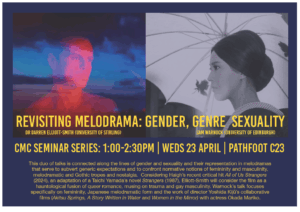
REVISITING MELODRAMA: GENDER, GENRE AND SEXUALITY
This duo of talks is connected along the lines of gender and sexuality and their representation in melodramas that serve to subvert generic expectations and to confront normative notions of femininity and masculinity, melodramatic and Gothic tropes and nostalgia both internal to and outwith their narratives. Considering Haigh’s recent critical hit, All of Us Strangers (2024) an adaptation of a Taichi Yamada’s novel Strangers (1987) Elliott-Smith will consider the film as a hauntological fusion of queer romance, musing on trauma and gay masculinity. Warnock’s paper focuses specifically on Japanese melodramatic form specifically the work of director Kijū’s collaborative films with actress Okada Mariko and their consideration of femininity.
Talk abstracts can be found below:
Keep The Vampires From Your Door’: Collapsing the Borderlands of Queer Melodrama/Horror in All of Us Strangers (Haigh 2024) – Dr Darren Elliott-Smith (Senior Lecturer in Film and Gender, University of Stirling)
Andrews Haigh’s All of Us Strangers (2024) offers a uniquely traumatic experience for some queer spectators. This is not only due to its deeply emotional and upsetting hauntological presentation of an 80’s-infused, painful nostalgic confrontation between the bereaved queer adult character Adam (Andrew Scott) and the spectres of his long-dead parents (played by Claire Foye and Jamie Bell); but also via the burgeoning queer relationship between Adam and the troubled Harry (Paul Mescal) a neighbour who taps into Adam’s grief and loneliness, experiencing the same disjointed liminal existence in a seemingly empty London tower block. Haigh’s sorrowful film, an adaptation of the Japanese novel Strangers (1987) by Taichi Yamada, appears at first as queer melodrama, but its utilisation of a hauntological queer historiography and an aesthetic that borrows liberally from the modern Gothic Horror, collapses generic and temporal borders while also offering a contemplation of a queer ontology that is bound up with, but resistant against, ‘chrononormativity’ (Freeman, 2010).
This paper wishes to read Haigh’s deeply affecting film as one that fuses queer love and horror as perpetually merged. It will build on the work of Elisabeth Freeman (2010), Heather Love (2009) and Carla Freccero (2006) on queer backwardness, hauntology and trauma. It will also extend on my own work on Queer Horror’s use of hauntology (2023) which allows for a queering of the dominant understanding of time and of history as linear, and a queer rejection of binaries enforced between past/future, normal/abnormal, Us/Them, then/now, dead/alive. Queer Hauntology then can be seen not as an act of productivity and forward momentum, but one of endless re-production, and of connection with a past and future that are still, in many ways, present. In particular, I want to offer a close textual analysis of Haigh’s film by way of Freccero’s thinking in Queer/Early/Modern (2006) whereby she explores queer sexual representation via ‘a particular (and partially imagined) traumatic past’. Haigh’s film blends horror and romantic loss to create a hauntological film that allows for ‘a spectral approach to an ethico-historical situation’.
Reimagining the ‘Woman’s Film’: The Subversive Melodramas of Yoshida Kijū and Okada Mariko – Sam Warnock (PhD candidate, University of Edinburgh, Events Assistant @ Creative Stirling)
Between 1965 and 1968, filmmaker Yoshida Kijū and actress Okada Mariko made a series of six ‘woman’s films’, which Yoshida claims were founded almost entirely upon the “physicality of Okada” (Yoshida 2020). These films have been placed in stark contrast to the conventional ‘post-war melodrama’, defined as ‘meta-melodramas’ (Saito 2010) or ‘anti-melodramas’ (Iwama 2023). Indeed, the couple critiqued the industry’s standardisation of this mode of production in their respective writings on cinema, where Okada outlined her difficulties of grappling with the need to be a star, and Yoshida attacked the industry’s capital-driven nature that necessitated a ‘humanistic’ and ‘apolitical’ address. Nonetheless, their collaborative partnership began and ended with melodrama, and most of their films centred around recalibrating this framework to allow for more critical examinations of women’s position in modern Japan. Furthermore, their commitment to melodrama also allows for a questioning of the oft-placed boundary between the classical and the modernist periods of the 1950s and 1960s respectively.
This paper will unpack the couple’s complex engagement with melodrama, subsequently rethinking how we engage with the concept of the ‘post-war melodrama’ in Japan more broadly. I will offer a brief overview of Yoshida and Okada’s outlook on cinema, before moving into an examination of their collaborative melodramas more generally, examining stylistic and thematic melodramatic elements from three distinct films: a studio production (Akitsu Springs), an independent production (A Story Written with Water), and a ‘late work’ (Women in the Mirror). In selecting these films, I aim to define their relationship with melodrama as consciously contradictory, as the films simultaneously adopted a melodramatic framework whilst also striving to move beyond what Yoshida and Okada deemed as its restrictive qualities. My analysis will be centred around two aspects in particular: the development of Yoshida’s visual style from studio filmmaking into independent modes of production, and an examination of Okada’s heroines within these films, who challenged traditional post-war archetypes such as the mother and the housewife.